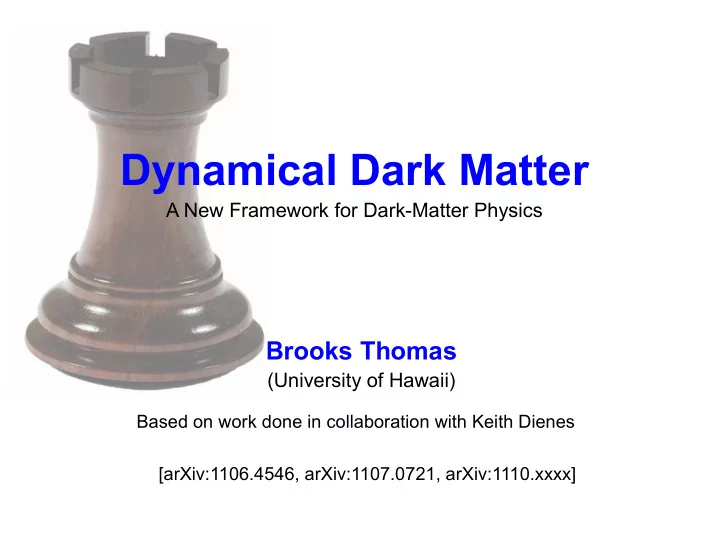

Dynamical Dark Matter A New Framework for Dark-Matter Physics Brooks Thomas (University of Hawaii) Based on work done in collaboration with Keith Dienes [arXiv:1106.4546, arXiv:1107.0721, arXiv:1110.xxxx]
A New Framework for Dark Matter Physics ● The dominant paradigm in dark-matter phenomenology has been to consider scenarios in which Ω DM is made up by one stable particle (or maybe two or three), but maybe nature isn't quite so simple. ● It could be that many particles – maybe even a vast number – contribute nontrivially to that abundance, with each providing only a minute fraction of the total. ● Some of these states may be only quasi-stable, but as long as the individual abundances are balanced against decay rates in just the right way, this can be a viable dark-matter scenario! “Dynamical Dark Matter”
Dynamical Dark Matter: The Big Picture Staggered onset times Increasing Mass
Non-minimal? Contrived? Ridiculously fine- tuned? Not at all! Over the course of this talk, I'll demonstrate how such scenarios arise naturally in the context of large extra dimensions. Moreover, I'll provide a concrete example of a viable model of dynamical dark matter, in which all applicable constraints are satisfied, and a large number of states contribute significantly toward Ω DM . This example demonstrates that dynamical dark matter is a viable framework for addressing the dark-matter question.
(General) Axions in Large Extra Dimensions ● Consider a 5D theory with the extra dimension 5D Bulk 3-Brane compactified on S 1 /Z 2 with radius R = 1/M c . ● Global U(1) X symmetry broken at scale f X by a bulk scalar → bulk axion is PNGB. ● SM and an additional gauge group G are Graviton restricted to the brane. G confines at a scale Λ G . Instanton effects lead to a brane-mass term m X for the axion. Axion Axion mass matrix: “Mixing Factor” Mass eigenstates
The Three Fundamental Questions: 1. “Does the relic abundance come out right?” must match [Komatsu et al.; '09] “Do a large number of modes contribute to that abundance, 2. or does the lightest one make up essentially all of Ω DM ?” “Tower Fraction” Define: “Is the model consistent with all of the applicable 3. experimental, astrophysical, and cosmological constraints?”
Mixing and Relic Abundances: “Misalignment Angle” (parameterizes initial displacement) ● m X becomes nonzero, so KK eigenstates are no longer mass eigenstates. ● The zero-mode potential now has a well-defined minimum. Coherent Oscillations (ρ∼ R -3 ) G Instantons True minimum
Initial Overlap Energy Densities 1. 2. Staggered Starts: Simultaneous oscillation times
The Contribution from Each Field Case I: All Case II: A Lot Simultaneous of Staggering
E Pluribus Unum: Ω tot from Ω λ The total relic abundance at present time is obtained by summing over these individual contributions. y=100 O O y=10 V V y=1 E E y=0.1 y=0.01 R R C C y=100 L L y=10 O O y=1 y=0.1 S S y=0.01 U U R R E E
η ≈ 0 y=100 y=10 y=1 y=0.1 y=0.01 η ≈ 0.2 Tower Fractions η ≈ 0 y=100 y=10 y=1 y=0.1 η ≈ 1 y=0.01
Mixing and stability: This balance between Ω λ and Γ λ rates relaxes constraints related to: ● Distortions to the CMB ● Features in the diffuse X-ray and gamma-ray background ● Disruptions of BBN ● Late entropy production
Mixing and axion production: Without mixing: With mixing: where (e.g. KK-graviton production) Suppression significantly relaxes limits from processes in which axions are produced, but not detected directly, including those from: ● Supernova energy-loss rates ● Stellar evolution ● Collider production (j+E T , γ +E T ,...) Decoherence phenomena (also related to axion mixing) suppress detection rates from: [Dienes, Dudas, Gherghetta; '99] ● Microwave-cavity experiments ● Helioscopes ● “Light-shining-through-walls” (LSW) experiments, etc.
Constraints on Dark Towers ● Therefore, while a great many considerations constrain scenarios involving light bulk axions, they can all be simultaneously satisfied. Eötvös experiments DM overabundant GC stars Helioscopes (CAST) Thermal production SN1987A Collider limits 5D Theory Inconsistent Diffuse photon spectra
Summary ● There's no reason to assume that a single, stable particle accounts for all of the non-baryonic dark matter in our universe. ● Indeed, there are simple, well-motivated BSM scenarios in which a large number of particles contribute non-trivially toward Ω DM. ● Production mechanisms (e.g. misalignment production) exist which naturally generate relic abundances for the contributing fields in such a way that an inverse correlation exists between Ω λ . and Γ λ . ● The same mass-mixing which gives rise to this correlation automatically suppresses the interactions between the lighter modes and the SM fields, making these particles less dangerous from a phenomenological perspective. The Take-Home Message: Dynamical dark matter is as viable a framework in which to address the dark matter question as any other.
Recommend
More recommend